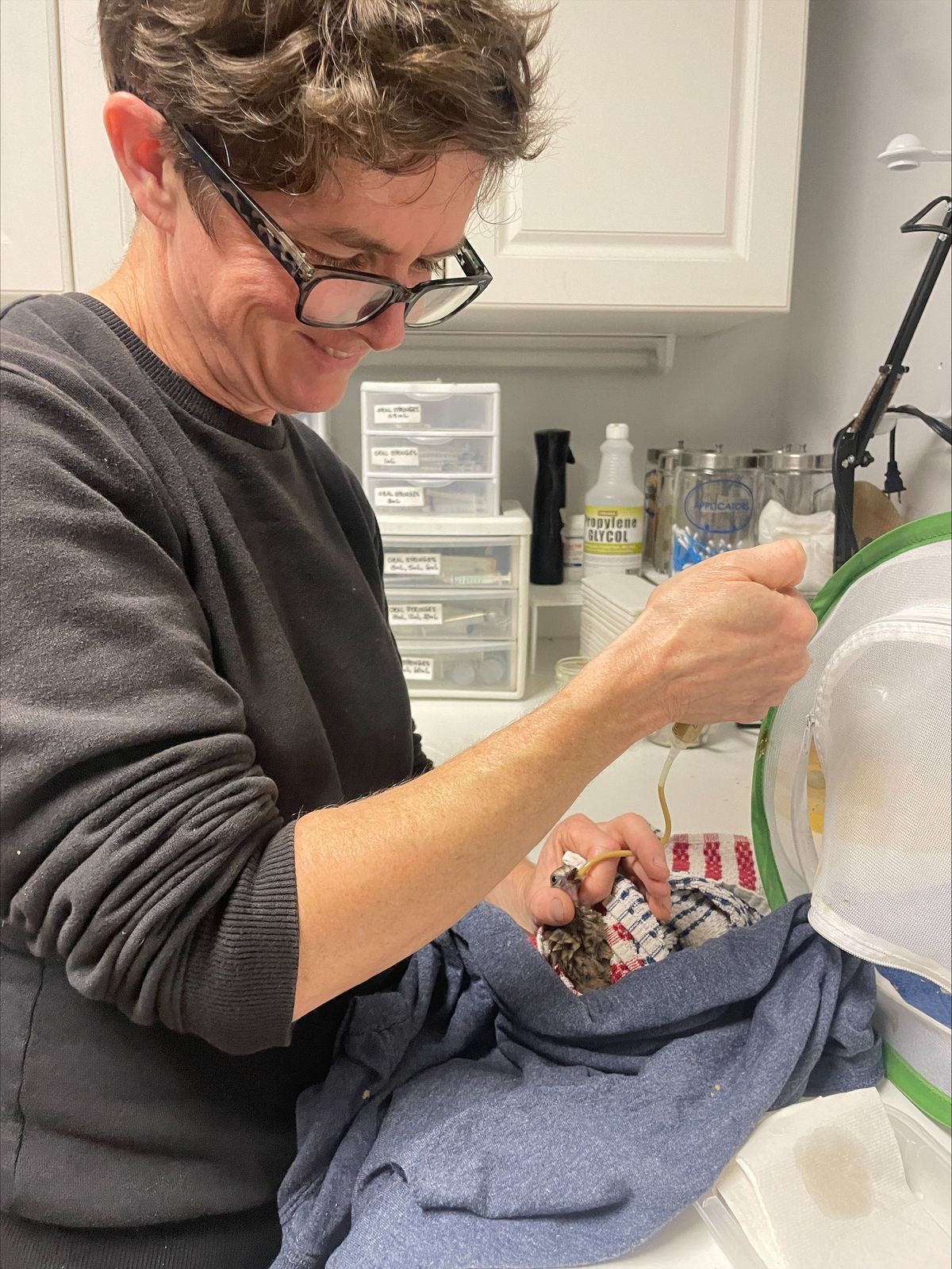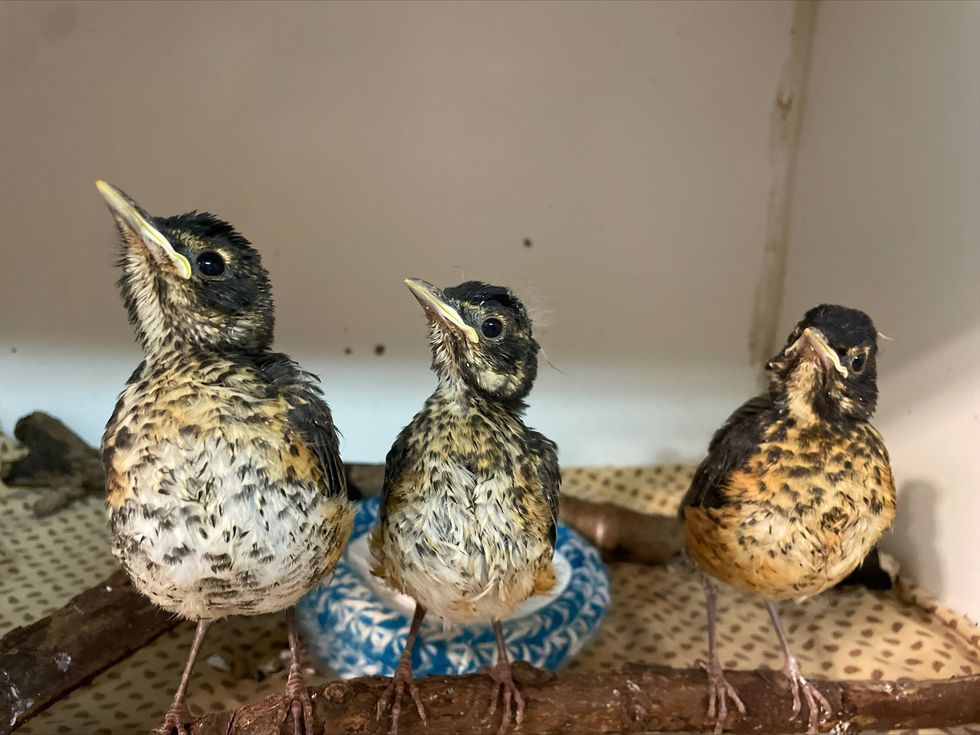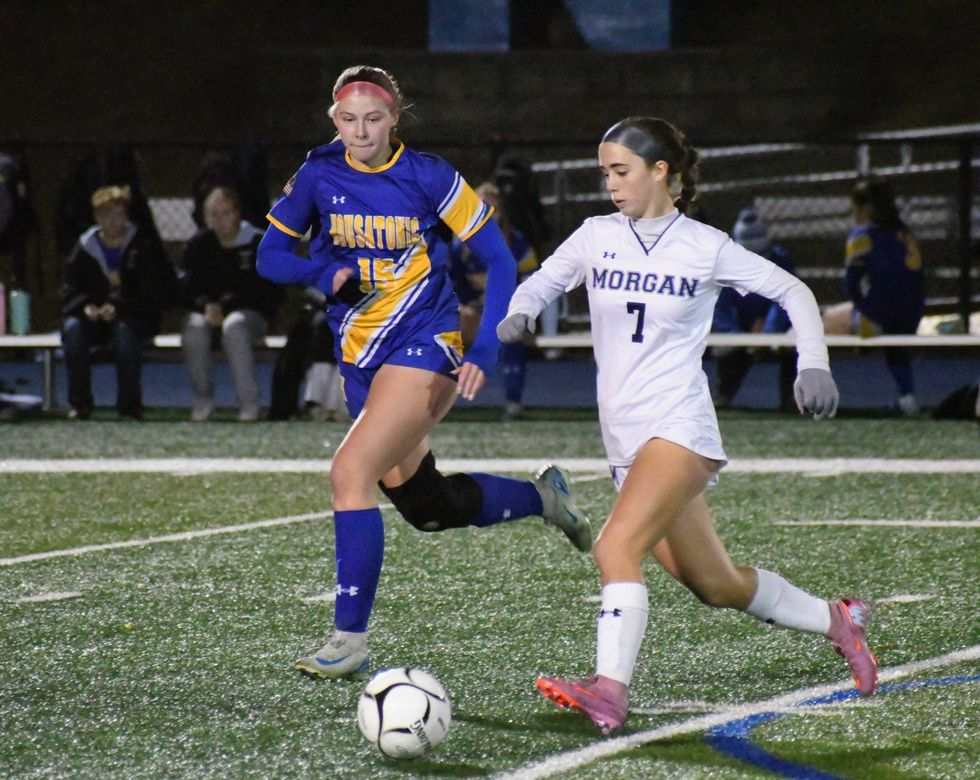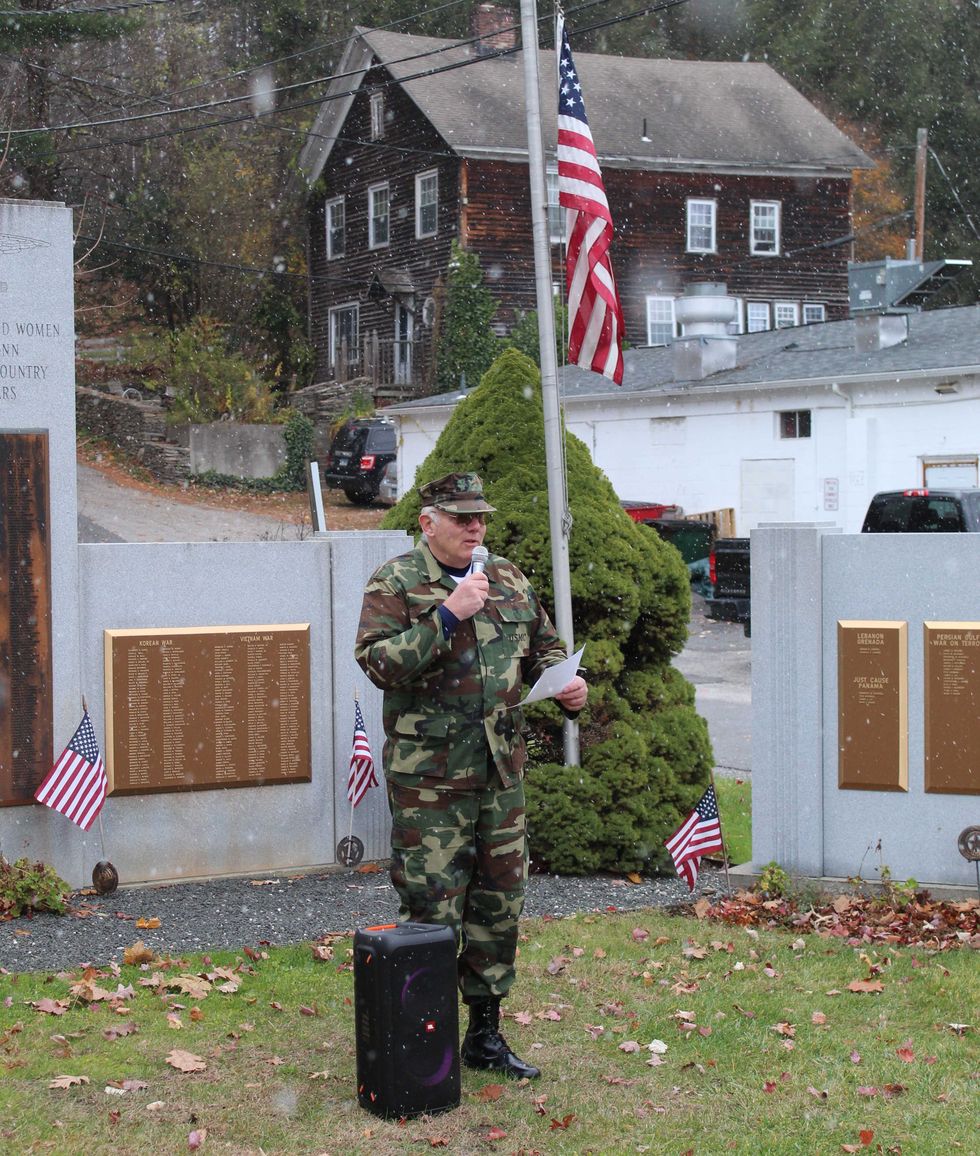Audubon’s efforts give injured animals new hope

Wildlife Rehab Volunteer Zoe Sheehan tube feeds a nestling Mourning Dove.
Provided

Wildlife Rehab Volunteer Zoe Sheehan tube feeds a nestling Mourning Dove.
SHARON — The Sharon Audubon Center located just off of Cornwall Bridge Road is made up of 1,149 acres of mostly woodland habitat and has helped countless animals return to the wild.
The refuge acts as a temporary home for injured and orphaned songbirds, birds of prey, small mammals and reptiles. Nationally it serves as one of two Audubon centers with an animal rehab clinic and, as stated by Director of Wildlife Rehabilitation Sunny Kellner, “is always busy this time of year.”
Kellner, who has been in the role since June 2015, grew up in the area and started working as a volunteer at age 13. It was at the Sharon Audubon that she discovered that helping animals could be both her career and lifestyle.
When asked about the rehabilitation process, she emphasized that every situation is unique and that there is “no one size fits all” for patient care. The process often starts with a report that an animal has been found either injured or orphaned and images are then taken of the animal to determine age, condition, and species.
Once brought in and a full examination is complete, patients are stabilized and treated for any life-threatening issues while also being slowly re-hydrated and fed. It is at this point that staff members and veterinarians will treat all other issues and administer any antibiotics. Continued care is provided up until the patient shows signs of self-reliance for two weeks (self-feed, weatherproofed feathers, ability to move freely).

The most common injuries seen in the clinic are derived from human impact, while toxicities and pathologies follow as other contributors. Examples of human impact injuries include motor vehicle/window strikes, attacks by house pets, and entrapment.
In the past few years, woodpeckers and nuthatches have been disproportionately affected by the sticky tape being wrapped around tree trunks. Put up in an effort to repel spongy moths, trunk space is now taken up by this plastic that is simultaneously trapping and killing bark-climbing birds.
The overarching goal of the clinic is to return the patients back to their natural environments as quickly as possible, but more importantly, in a viable state. For some patients this may mean being in the clinic for a few days while others need to stay closer to a year. Of the small mammals that the Sharon Audubon does take in, porcupines are at the forefront.
Kellner, who specializes in porcupine rehab, explained that the babies typically stay over winter and are released in the spring. The release rate for all species falls between 40-43%.
Animals that are “non-releasable” due to human imprinting or permanent injury typically become residents. Current resident animals include the reptiles on display in the Education Center and the raptors in the outdoor aviaries.

Though the clinic is animal-centered, it is human-dominated. The amount of help and the speed at which animals receive it, is dependent on the number of people ready to jump in. The summer months, commonly referred to as “baby season”, are especially busy. Volunteers and staff work around the clock feeding and caring for baby birds of all species, but specifically Chimney Swifts.
“They need to be fed about every 20 minutes for at least 14 hours,” stated Kellner.
Volunteers learn just about everything - how to feed, handle, identify, and care for patients. They are welcomed year-round with no prior experience required, just the desire to help.
The sprawling property is home to 11 miles of trails, two ponds, raptor aviaries, the Pollinator Garden and a working sugarhouse. In addition to animal rehabilitation, it functions as a community nature center where people of all ages have the opportunity to engage and educate themselves on local wildlife.
The Sharon Audubon has plans to extend their premises in the coming years, providing a larger space for wildlife rehab. Though still in the works, the goal is to have waiting, triage, and isolation rooms, as well as more aviaries and storage areas. It is anticipated that this building will be separate from the public areas, allowing more privacy for patients. The planning of this project comes at a “great time” as pressing illnesses and more regulations are being brought up.
NEWTOWN — Housatonic Valley Regional High School's girls soccer team's state tournament run concluded in the semifinals with a 4-2 loss to Morgan High School Wednesday, Nov. 12.
The final four finish was the deepest playoff push for Housatonic since 2014. Lainey Diorio scored both goals and keeper Vi Salazar logged 10 saves in the semifinal game.
"It's an unfortunate loss but you know they played their hearts out," said HVRHS coach Don Drislane. "Awesome season."

It was the final soccer game for HVRHS’s two senior captains: Ava Segalla and Madeline Mechare. Segalla ended her varsity career as the leading goal scorer in school history with a total of 133.
Morgan's size and speed on the field helped the Huskies dominate possession and earned them a bid to the Class S girls soccer championship for the second year in a row. In 2024, Morgan lost in penalty kicks to Coginchaug High School.
This year, the Huskies will face Old Saybrook High School in the Class S championship game at Trinity Health Stadium in Hartford on Saturday, Nov. 15 at 10 a.m. Old Saybrook defeated Canton High School 1-0 in the semis.
Local writer shares veterans’ stories in Malcolm Gladwell’s ‘Medal of Honor’ podcast
SHARON, Conn. — After 20 years as a magazine editor with executive roles at publishing giants like Condé Nast and Hearst, Meredith Rollins never imagined she would become the creative force behind a military history podcast. But today, she spends her days writing about some of the most heroic veterans in United States history for “Medal of Honor: Stories of Courage,” a podcast produced by Malcolm Gladwell’s company, Pushkin Industries.
From her early days in book publishing to two decades in magazines and later a global content strategist for Weight Watchers, Rollins has built a long and varied career in storytelling.
“I’ve learned a lot with each career shift, but the higher I went up the masthead, the less it was about writing and editing,” said Rollins. “I missed the creative process.”
While the podcast isn’t her first writing project, it marks her first foray into audio storytelling.
“During the pandemic I used to listen to mostly true crime podcasts when I was doing the laundry, driving my kids somewhere or working in the garden,” she said. Now Rollins gets to write one, and approaches each episode with awe and a reporter’s curiosity.
After 30 years of friendship with Malcolm Gladwell, the pair decided to collaborate on a project that would combine their shared journalism roots with stories that celebrate bravery and courage.
“Malcolm approached me about a project, and he was looking for a subject that he believed would really bring people together in this fractured political time we’re going through,” said Rollins.
Enter “Medal of Honor.”
The podcast’s namesake is the highest U.S. military decoration for valor, awarded for “conspicuous gallantry and intrepidity at the risk of life above and beyond the call of duty.” Each episode brings to life the story of a Medal of Honor recipient — often with the cinematic pacing and emotional resonance of a feature film.
“Medal of Honor” released its second season this summer, and production on a third season is underway. While Season One was narrated by Gladwell himself, Season Two introduced a new voice with firsthand experience. J.R. Martinez is a former U.S. Army soldier, author, motivational speaker and winner of Dancing with the Stars Season 13.
Writing for two very different narrators, Rollins said, has been both a challenge and a joy.
“As we’ve gotten to know each other and gotten deeper into this project together, I can almost predict how J.R. will react to certain moments,” she said. “He brings so much heart and humanity to the stories.”
Both her father and father-in-law served as Marines, but Rollins said military history was never top of mind until Gladwell pitched her the idea.
“The deeper you get into a subject you don’t know about, the more excited you get about it,” she said. “It’s been a way for me to learn about the incredible sacrifice woven into our country’s history.”
Rollins approaches each episode of “Medal of Honor” by looking first at the act of sacrifice itself, which she describes as “a moment that often happens in a flash.”
She dives deep into research, gathering biographical details from their upbringing and motivations to the circumstances that led them into combat. She then recreates the atmosphere of the conflict, setting the scene with vivid historical detail.
“These men would tell you they were just average guys,” said Rollins. “And if you believe that, then you have to believe we’re all capable of that same bravery or selflessness. It has really shown me the incredible courage we all have, and our ability to do right in the world.”
Chris Ohmen (left) held the flag while Chris Williams welcomed Salisbury residents to a Veterans Day ceremony at Town Hall Tuesday, Nov. 11.
SALISBURY — About 30 people turned out for the traditional Veterans Day ceremony at Salisbury Town Hall on a cold and snowy Tuesday morning, Nov. 11.
Chris Ohmen handled the colors and Chris Williams ran the ceremony.
Rev. John Nelson from Salisbury Congregational Church gave both an invocation and a benediction. The latter included this:
“We pray that those who have served and those who have died will never have done so in vain/We pray that the commitment of veterans will be an abiding call to resolve our conflicts without resorting to arms/ That one day soon we may mark the war that indeed ends all wars.”

Williams began his remarks by noting that the Veterans Day speech was usually given by the late David Bayersdorfer, who died earlier this year.
“As we honor our veterans today, let’s keep in mind that service comes in many forms. Each role, each job, each post is a vital part of what makes our military the finest in the world.”
Lloyd Wallingford sang “God Bless America” a cappella, with the crowd joining in.